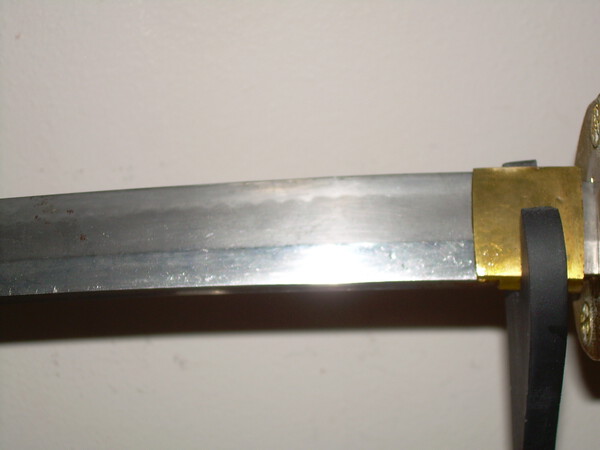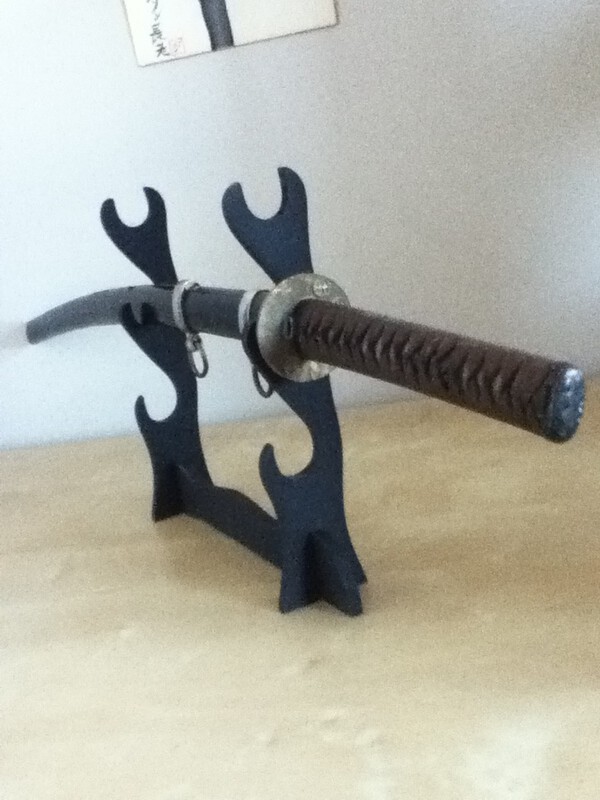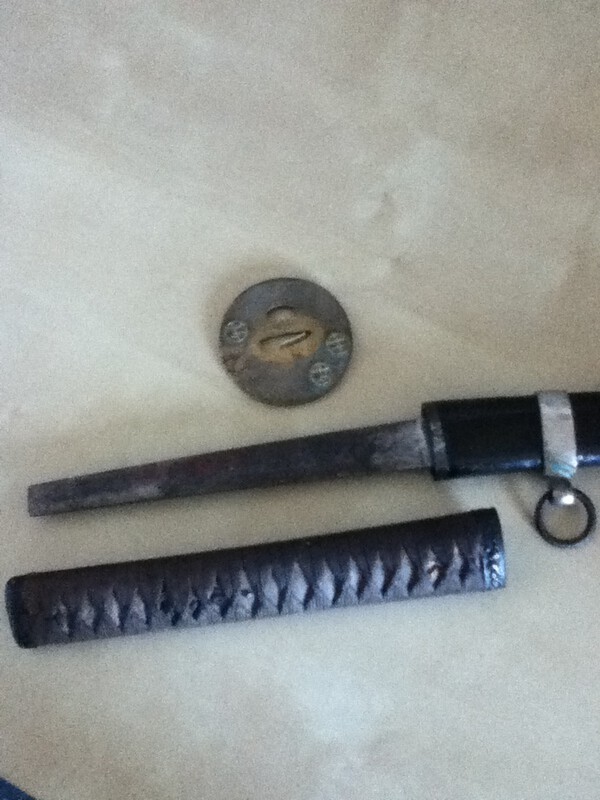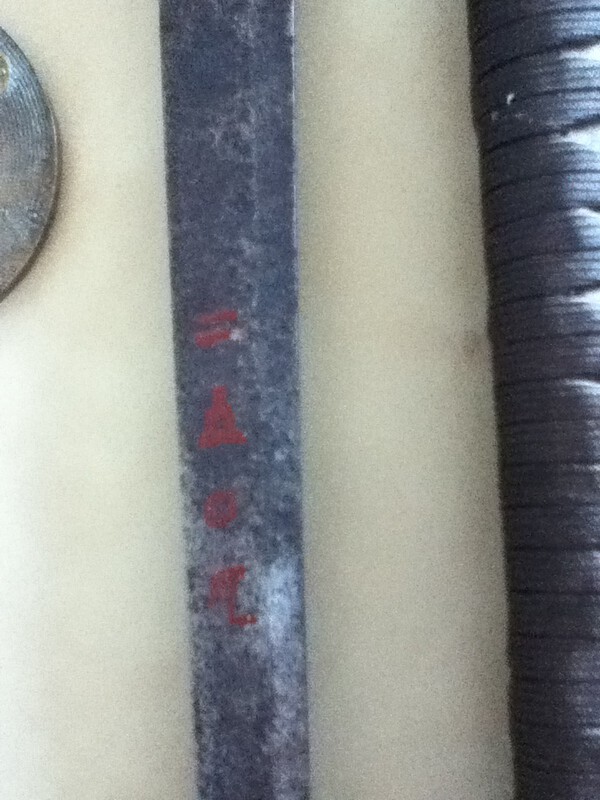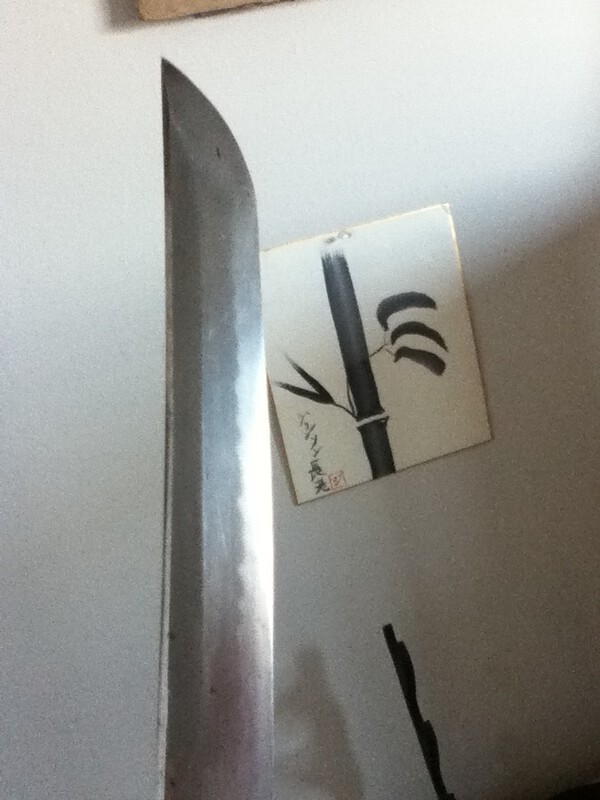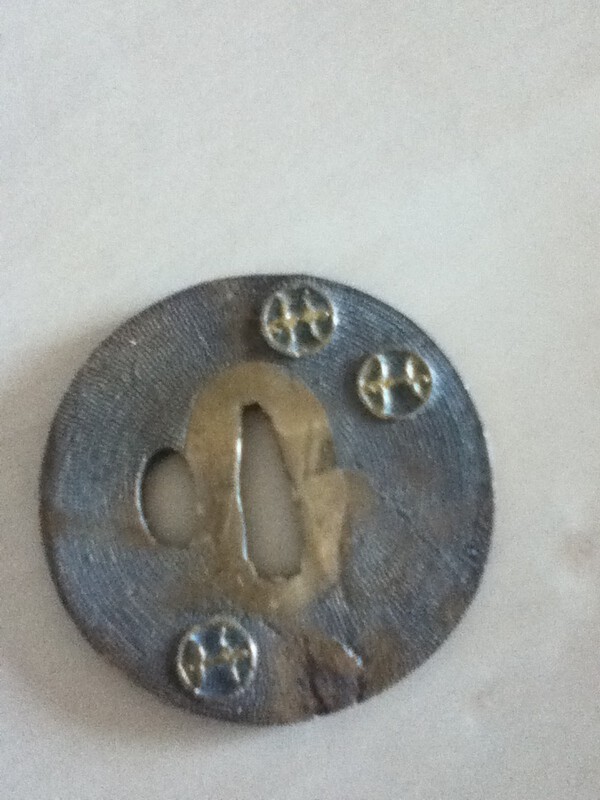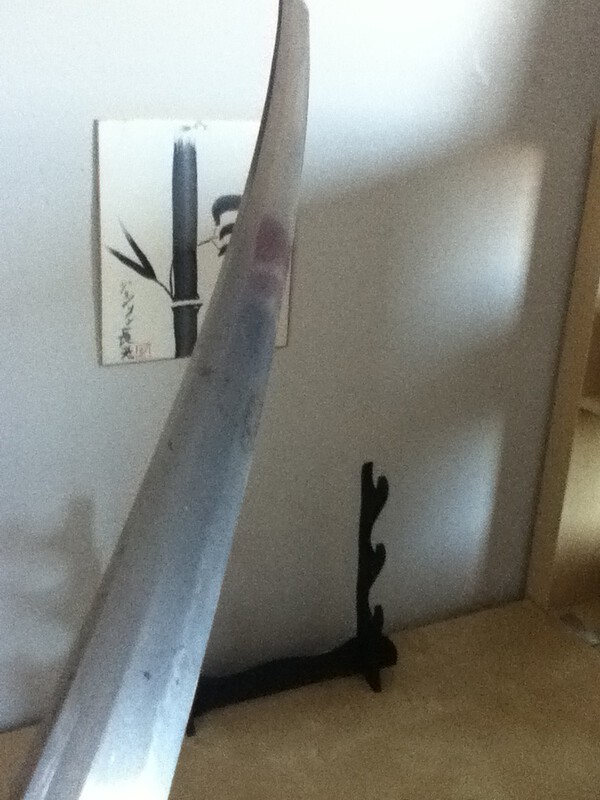-
Posts
10 -
Joined
-
Last visited
Everything posted by 8 Ball
-
Hey everyone, I’ve had this sword for awhile now and am curious if anyone is able to identify it or would be able to provide any information on it. It is signed, however I have had no luck in translating the mei, due to its condition. Hamon is Suguha. Kissaki is possibly Ko-Kissaki Measurements are as follows: Length from Kissaki to machi: 25” width at machi: 1 1/8” Thickness at machi: 5/16”
-
-
Having a little bit of trouble with this one and was hoping you guys could help me out. The signature is on the Tachi Mei side. If it’s a smith’s signature then I don’t have any idea, however if it is a date marking/nengo it looks to be possibly Eikyo (could be mistaken, just trying to go off what I see). Measurements; Length from Kissaki to machi: 25” width at machi: 1 1/8” Thickness at machi: 5/16”
-
Having a little bit of trouble with this one and was hoping you guys could help me out. The signature is on the Tachi Mei side. If it’s a smith’s signature then I don’t have any idea, however if it is a date marking/nengo it looks to be possibly Eikyo (could be mistaken, just trying to go off what I see). Measurements; Length from Kissaki to machi: 25” width at machi: 1 1/8” Thickness at machi: 5/16”
-
Hello everyone, I need help identifying what era my katana is from and any other possible information. Any and all help is appreciated! I wasn’t able to get the Habaki off, however I was able to slide it down enough to get a measurement of the machi. Measurements; Length from Kissaki to machi: 25” width at machi: 1 1/8” Thickness at machi: 5/16” Thank you again for your help and consideration!
-
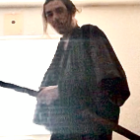
RE-Post Officer's Katana Identification
8 Ball replied to 8 Ball's topic in Military Swords of Japan
Well, what I do find interesting is there are little hishigami paper triangles tucked under every crease of the ito; they seem to be quite aged, so I don't think the wrap or the menuki were a 'later edition'. The Nakago has no other marks then those numbers, but you can clearly see the file marks on the tang. The polish is in fairly bad shape, so I can't see any large noi but in some parts I think I can see teeny-tiny nie. The polish is bad enough to the point where I can't see a hada, and I was lucky to even get clear enough pictures of the hamon with the shape it's in. The tsuba fits the blade fairly well, and I only had to fashion a very tiny bamboo wedge to slip between the tsuba and the nakago to have a snug fit. There were no seppa on the sword when I bought it, so there is a small amount of movement of the tsuba, but I figure I could get some cheap antique ones somewhere to fix that. It is not very clear in the pictures, but you can see the hamon run down underneath the habaki and up through the kissaki, but the polish is pretty bad, so it's harder to see not-in-person. Thanks for the reply btw, I was almost thinking everyone forgot about me. :D -
Hello everyone! I have recently taken some new pictures of my sword with my junk Nikon (which is the best thing I have next to a cell phone camera) and I have made an effort to be more object when I took these, so hopefully they're more helpful then the last batch. Any and all help is much appreciated in identifying anything about this sword. Thanks!
-
Thank you for the input. I have promptly changed my signature to 'Max J.'; you can address me as Max I have also resolved to try a better camera when I try to upload pictures. I just used my Ipod camera on those pictures, and now realize that I'll need to use my Nikon. Thanks!
-
Alright, here are some pictures. Sorry if they're bad quality, I tried to get the best photos I could.
-
Thank you very much for the reply. Yes I do hope it's more than a cheap oil quenched gunto. I just wonder what the paint on the tang means. I thought they only painted those on production swords? I'll do my best to upload some pictures. Do you have any advice as to the easiest way TO upload pictures? I'm kind of a newbie and appreciate all the help I can get
-
Hello fellow forum members! I have recently joined this forum and am excited to speak to fellow enthusiasts, and to receive some help on topics. To cut right to the chase, I need some help identifying a sword I have acquired from someone locally. It is clearly a WW2 era sword, but I have some questions about the mounts and the blade. I'll be trying to upload some pictures later, but for now I'll do my best to describe it. First of all, the blade is not mounted in NCO or conventional Gunto mounts. The Kashira is not the nearly iconic gunto pommel that you all can visualize (you know, the ones that have the little loops for the tassels and where the same goes underneath the kashira). The Fuchi and Kashira seem to resemble more civilian looking mounts that appear to be made of an iron. The Kashira is squared off on the end like most non-military Katana (somewhat resembling an 'end of war' pommel but doesn't seem to be bad quality at all) and has a very nice Ura end knot, but no little loop for the tassel. The Tsuka is very well wrapped in brown silk Ito, and (surprisingly to me) has little Hishigami triangles tucked under each of the creases. The Samegawa almost looks like Snake skin, the scales/granules are VERY small, which I can only assume means low quality. But, another thing that intrigues me about the tsuka is that it doesn't have the typical gunto menuki tucked under the Ito. The Menuki appear to be the same material as the Fuchi and Kashira and looks very high quality. The menuki doesn't resemble the typical flowers a normal gunto would, but appears to be either an animal or a person (my best bet being a monkey, but I wouldn't put money on it). The Tsuba is another thing that I find is VERY different from other Gunto. Firstly, the tsuba is round and flat, and is NOT the typical imperial army tsuba that are more square shaped. It is round and the metal is yellowish (my best bet being that it is made of brass) and has only one Kozuka-ana. It has no major holes other than the kozuka and the ana for the blade, and is relatively thick. The metal is pleated (has a rougher texture, with little uniform bumps) and has what appear to be two little ring designs on each side. I have not been able to find another tsuba like this, so this is a quite intriguing find for me. The Saya is really the most typical thing about the sword. It is painted black and has two ring-mounts, but is in pretty bad shape and has a crack running down the front. The tang has one mekugi-hole that appears to be punched, not drilled, and DOES have 4 red-painted numbers:(from top to bottom) 2509. Other than that there are NO STAMPS or signatures and it has a relatively dark rust patina. The blade has no bo-hi and has a few tiny dark rust patches along the surface. The blade does have a hamon, which I can best describe as Sanbonsugi or Choji Gunome. The blade is in need of a polish and I can barely see the hamon in the shape it's in, so I can't really see any visible Nie. Normally I'd coin this as just oil-quenched, but there's two reasons I might think it could be something more. Firstly, I've used the good-ol' printer paperprinter cut test, and have tested the entire length of the blade to see that it is sharp even down to the Habaki. Cuts better than most repro blades I have. Also, even though the hamon is harder to see, I can clearly see it runs underneath the habaki and right down to the tang, and runs evenly and clearly through the Kissaki straight to the tip. It's fairly inactive, but changes between very close little 'spikes' to even undulating waves near the bottom of the habaki and through the kissaki. I have been able to catch the light on it (not sure how to put this) and 'light up' the hamon to see it has a different kind of shine than the rest of the blade (Sorry, I'm being really vague here, I'm not quite an expert). Any help is appreciated and I'll try to get pictures up ASAP. Thanks!


















